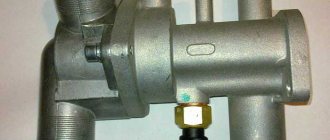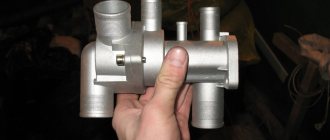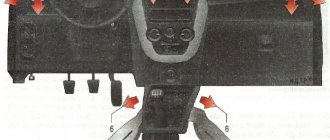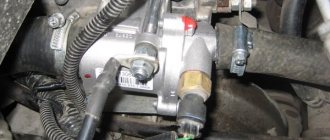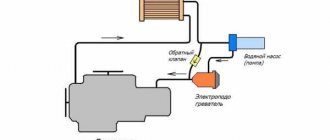VAZ cars of different models differ in the operating principles of many systems. There is a difference in the engine cooling and interior heating systems.
The article describes how to install a Granta thermostat on a VAZ-2110.
The main differences between the engine heating systems of the two models will be described, as well as the best thermostats that can be used for replacement.
Installation of the Grants thermostat on VAZ 2110, 2112
| It is no secret that the production of VAZ cars of the tenth family in Russia has already been completed. However, nothing prevents owners from improving their cars by replacing outdated parts with more modern ones, from foreign cars or VAZs of the latest years of production. An example of this would be replacing a VAZ 2110 thermostat with a Lada Granta thermostat. |
Differences between the Granta cooling system and the VAZ 2110, Priora
Will need to buy
- Thermostat Lada Granta (catalog number: 21900-1306010-00), price 640 rub.
- Gasket for the thermostat (same as standard), price 8 rubles.
- Lower radiator pipe for Lada Granta (1 self-tightening clamp included), price 440 rub.
- M8 studs, approximately 85mm long, price 20r.
Replacing the thermostat
All that remains is to pour new antifreeze into the cooling system and start the engine. During warming up, monitor the temperature of the antifreeze and the tightness of all connections.
Thermostat connection diagrams Grants for VAZ
Conclusion
Based on observations, we can say that the stove begins to blow warm air already at 55 degrees of coolant, and at a temperature of 70 degrees hot air is already coming from the stove (not only while driving, but also at idle). While driving, the engine temperature is kept between 85-90 degrees. In traffic jams, the engine does not overheat, and the temperature ranges from 95 to 105 degrees, the radiator fan of the cooling system turns on.
More detailed observations are described on the forum. By the way, the SOD on the “ten” can also be remade according to the Lada Kalina type.
| I remade the SOD VAZ 2110 according to the Grants scheme and Which Granta thermostat connection diagram is best to choose? |
Photo source: Key words:
Changing the thermal insert
You can replace the entire thermal insert. Wahler inserts are ideal for the standard Grant thermostat: 3017.87 D (at 87° C) and 3091.92 B (at 90° C). The insert changes along with the spring. This modernization is carried out using thermostats manufactured by BEHR (which is equipped with the new BAZ-2190 car). There is no need to make any modifications or fit new parts. The BEHR thermostat is dismountable, and the Wahler “thermos” will have to be cut with a hacksaw in order to remove the thermocouple.
Alternatively, you can use a Daewoo Nexia, Renault Logan or Vernet 4898.92 part as a “donor”, but the diameter of the latter’s thermoelement is slightly larger than necessary and requires adjustment. For Luzar models such a replacement is not possible.
Some car enthusiasts who have made this modification claim that fuel consumption, although slightly, has decreased.
Source
Why do you need to replace the thermostat on a VAZ-2110
Experienced car enthusiasts claim that replacing the “native” thermostat of the VAZ-2110 with the same device from Granta will help warm up the engine, and therefore the car’s interior, faster. Such changes in engine operation depend on the functional features of the replaced thermostat from Granta.
The fact is that this device is responsible for the redistribution of fluid flows in the vehicle engine cooling system. A standard automotive engine cooling system contains five required components:
- Water pump.
- Electric fan.
- Radiator.
- Expansion tank.
- Thermostat device.
Through such a cooling system, a special liquid can circulate without a radiator, that is, in a small circle.
And in the VAZ-2110, even in a small circle, the cooling process involves:
The thermostat begins to function at the optimal temperature – 87 degrees. As soon as this temperature is established, the main pipe of the thermostat device opens and the coolant begins to circulate in a closed circle of the vehicle engine cooling system. As the temperature increases, the valve opens more and more, up to a maximum hole diameter of 8 millimeters.
general information
There are single-valve, two-stage and two-valve thermostats, as well as electronically controlled devices. Grants are equipped with thermostats Luzar LT0191 and Luzar LT0190 (costing from 450 rubles for the first, and from 800 rubles for the second), FENOX TS034E7 (costing from 800 rubles), VAZ-2123 (article 2123-1306010, cost from 650 rub.). It is worth mentioning such devices as VAZ-2101 GATES (article TH14580, cost - from 350 rubles), VAZ-2121 GATES (article TH15380, approximate cost - from 500 rubles), VAZ-2110 (article 21082-1306010, cost - from 600 rub.) and other devices. They are located between the engine and the radiator, but it should be noted that there are differences in the location of the thermostats on Grants with eight-valve and sixteen-valve engines.
Their main task is to prevent the movement of antifreeze through the radiator until the car engine warms up to the required temperatures. Accordingly, if the car engine does not warm up, then the coolant does not move in a large circle. Usually the thermostat is activated when the engine reaches a temperature of 80-95C. Among other things, the thermostat helps reduce the amount of harmful emissions released into the atmosphere and minimize engine wear.
The thermoelement located inside the device is made of brass, has a cylindrical shape and is filled with artificial wax. When the engine reaches a temperature of approximately 82C, this substance begins to melt, which causes it to expand. This sets the valve in motion, it opens, after which the antifreeze begins to circulate through the car’s radiator. Turning off the motor causes the wax to solidify inside the thermostat and close the damper.
Below we will talk in more detail about possible malfunctions of thermostats, provide instructions for replacing and checking them, and also share a technique for reworking and upgrading this part, allowing you to increase its response threshold to 92C.
How does the VAZ-2110 engine cooling system differ from Granta?
Using diagrams that are easy to find on the Internet, you can trace the difference in the engine cooling systems of the VAZ-2110 and Grants.
In the VAZ-2110 car, experienced car enthusiasts note a number of shortcomings in the operation of the thermostat device. First of all, these include:
- Frequent leaks of coolant from the engine cooling system.
- Problems with the expansion tank.
But the Granta cooling system is different in that it:
- liquid;
- closed;
- with forced circulation.
In this case, the coolant enters the thermostat element through the pump.
The main differences between the engine cooling systems of both cars are:
- In Granta, the stove is connected in a sequential manner (as a result of this connection, the number of revolutions of the pump does not have any effect on the heating device called “stove”; there is no process of heating the coolant in the radiator and expansion tank).
- For the VAZ-2110, the stove is connected in parallel.
As you can see, there are differences in the cooling systems of Grants and VAZ-2110, and upon closer examination they are quite significant.
Signs of breakdown
The thermostat is a fairly simple element, however, and it is not immune to breakdowns. Normally, after starting a cold engine, the lower hose extending from the radiator does not heat up for some time, but after the coolant temperature exceeds 85C (±2C), it begins to quickly heat up (provided the thermostat is in full working order). It is this aspect that will accurately indicate to the car owner the moment the coolant begins to circulate.
In cases where the valve cannot open, the coolant stops circulating and the engine begins to overheat. Overheating also causes incomplete opening of the valve. A delay in closing the valve, on the contrary, creates conditions for a longer warm-up of the engine, especially in the cold season.
As a rule, thermostat failure is caused by the following reasons:
- an unstable engine (triplication often leads to valve damage);
- wear of the rubber gasket;
- corrosion (it is the most common cause of breakdowns);
- antifreeze gets inside the thermostat;
- there is a leakage of wax from the device;
- there is mechanical damage on the valve.
Most often, a malfunction of the thermostat leads to the impossibility of further movement in the car, and therefore the faulty part must be replaced immediately.
How to install a thermostat from Granta on a VAZ-2110
In order to replace the “native” thermostat device of the “tens” with a thermostat from Granta, you need to perform a number of preparatory procedures. First, remove the “original” thermostat from the VAZ-2110. This is done in several steps:
- loosen the radiator hose clamps – outlet and inlet;
- dismantle the thermostat device.
Secondly, they conduct a comparative analysis of the cooling systems of both vehicles (we did this in the previous paragraph of this article).
Thirdly, purchase the necessary parts that will be involved in the procedure for installing the Grants thermostat on the VAZ-2110:
- The thermostat itself.
- The lower pipe to it.
- Gaskets.
- Washers.
- Clamps.
- Antifreeze.
- Sealant (for example, Abro).
Only after these three main steps can you begin the procedure for replacing the thermostat device from Granta to VAZ-2110. To do this, experts recommend following the following instructions:
- drain the antifreeze from the VAZ-2110;
- unscrew the bolts securing the “original” thermostat device;
- dismantle the temperature sensor;
- remove the studs, lower pipe;
- install a new pipe (do not forget to tighten the clamps);
- plug the hose that comes from the throttle valve using an M10 bolt and clamps;
- install new studs of the thermostat device;
- install the Granta thermostat;
- connect all the hoses (to do this, the hose from the heating device will have to be cut on site to a suitable size - approximately 5 centimeters);
- install the previously removed temperature sensor;
- connect all wires;
- assemble the air pipe;
- connect the filter.
After all these steps, you will still have the “native” VAZ-2110 thermostat and the pipes that came with it. To check the operation of the “new” thermostat device, you need to pour new coolant into the cooling system of the VAZ-2110 engine, and then start the vehicle engine. Do not forget to monitor the heating temperature of the coolant and regularly check the tightness of all connections.
Tools for repair
Before you begin installing the Granta thermostat on the VAZ-2114, you need to partially disassemble the cooling system. And for this you will need the following set of tools:
- Phillips and flathead screwdrivers.
- A set of wrenches - spanners, open-end wrenches, socket heads.
- Silicone sealant.
- Clamps – at least 4 pcs.
- Thermostat from Granta.
If necessary, be sure to purchase new pipes. If the old ones are damaged, then after dismantling they may not be able to be reinstalled. Sometimes rubber is cut with clamps, so tighten as carefully as possible. Be sure to carry out all work on a cooled engine - this way you will ensure safety and the likelihood of getting burns becomes less.
What are the advantages of replacing the thermostat from Granta to VAZ-2110
Experienced car enthusiasts note several main advantages that the owner of a VAZ-2110 acquires after performing the procedure for replacing the thermostat device from Granta. The most notable ones include:
- a significant increase in temperature inside the car;
- temperature stability regardless of vehicle operating mode.
From reviews of car owners who have already performed the thermostat replacement procedure:
- Warm air from the stove enters the car interior already at 55 degrees on the temperature sensor of the thermostat device.
- Hot air is felt at 70 degrees (this is noticeable even when the car is in idle mode).
- In traffic jams, the power unit does not overheat.
- The temperature range of the thermostat does not exceed 100 degrees (this limit is achieved using a fan, which starts at a critical moment).
Technical points
Regardless of the vehicle brand, the ODS consists of the following elements:
- Water pump.
- Electric fan.
- Radiator.
- Expansion tank with plug.
- Thermostat.
On a cold engine, the valve of the latter device closes the pipe going to the radiator. In this case, coolant circulation is observed in a small circle (without a radiator). On the “ten”, the radiator, intake manifold, BDK, and liquid chamber are involved in a small circle. At a temperature of 87°C, movement of the thermostat is observed. This opens the main pipe. The liquid begins to circulate in a large circle. If the temperature reaches 102°C, then the pipe opens completely. The valve stroke is allowed within 8 mm.
SOD Priors and Grants are liquid, closed and with forced circulation. The liquid enters the thermostat through a deposit and a special jacket.
How to correctly determine that the device is in working condition?
We warm up the engine to such a temperature that the needle does not reach the critical value, and turn it off. We open the hood, find a hose on top of the radiator (a black rubber hose with a metal clamp at the end) and the same one on the bottom. Then, very carefully, they may be quite hot, touch them. If one of them becomes hot, and the other is still cold, and the sensor shows a high engine temperature, this means that most likely the liquid does not enter the engine, but is retained in the radiator, and you need to change the thermostat to a new one.
Modernization of the "tens"
First, the old thermostat is removed from the “tens”:
- loosening the clamps of the radiator outlet and inlet hoses;
- dismantling the device.
The next stage is a comparative analysis of Granta SOD and VAZ 2110. On the first vehicle, the stove is connected in series, and on the second - in parallel. On the Lada Granta, the performance of the heating device does not depend on the pump speed. At the same time, the antifreeze in the expansion tank and radiator does not warm up.
The thermostat replacement process is carried out after purchasing the following parts:
- gaskets;
- lower pipe;
- washers;
- clamps;
- antifreeze;
- ABRO sealant.
The thermostat is installed on the VAZ 2110 after draining the antifreeze. To plug the hose coming from the throttle valve, use an M10 bolt and clamps. The next stage is connecting the hoses and installing the temperature sensor.
Tuned SOD system on a VAZ 2110: the stove inlet is connected to the thermostat, and the drain is connected to the saxophone. The damper heating is not activated. If necessary, connect a hose from the stove radiator to the throttle, which goes to the expander. Then pour antifreeze into the SOD and start the engine. During the warming up process, it is recommended to monitor the temperature of the antifreeze and the tightness of the connections. If there are no violations, then the tuning was successful.
Experts include the following advantages of such a replacement:
- warmth in the cabin;
- stable temperature under different operating modes.
The “new stove” will start blowing warm air at 55°C, and at 70°C hot air will come out of the stove (at idle and while the vehicle is moving). When driving, the engine temperature level will be within 85°C. At the same time, the power unit does not overheat in traffic jams, and the temperature is within 100°C. This helps the fan start.
Additional tuning
To make the thermostat work better, the bypass will need to be modified. A thermostat with 6 holes ensures quick heating of the air in the cabin (due to the reduction of the channel). The volume of liquid that circulates through the valve depends on the diameter of the bypass. As the channel decreases, the flow through the heating device increases. The interior of the “tens” becomes warmer.
When narrowing a thermostat with 5 holes, problems may arise with flushing the thermal element. To narrow the channel to the desired diameter, an aluminum plate is required. It is mounted inside the bypass. To do this, use rivets or cold welding. A new hole is drilled in the plate.
The tuned thermostat consists of a housing with an additional sixth hole (for the pipe), the pipe itself, threads, throttle washer, vehicle head, thermoelement and adjusting bolt. The pipe is screwed in and cold welded.
An additional pipe is installed parallel to the standard one on the stove (to allow the return flow from the heating unit to enter the measuring cavity of the vehicle). To increase the coolant current on a small circle, you will need a throttle washer. This eliminates pressure drop.
The adjusting bolt should rest against the leg of the element. This will allow you to regulate the opening temperature of the vehicle from the outside. Since the standard TS-82s are cold, additional modernization will be required. Experts advise converting carburetor TS-82s into injection ones. To do this, you need to drill and tap a thread for the DTOZH.
A tee is used for tuning. On the “ten” it does not need to be deployed. A thermostat with 6 holes, unlike the previous element, is easier to tune. After reducing this bypass, the coolant temperature will depend on the radiator temperature.
Refinement of a budget car
You can install a thermostat from Granta to Priora. To do this, you will need to buy pipes, a gasket, a tee, a temperature sensor, studs, and antifreeze. Since the Granta, unlike the Priora, has a radiator located further from the engine, a long pipe will be required for tuning.
You can splice standard pipes. To do this, use the SOD pump pipe from the “ten”. A straight section with fasteners is cut off from it. Experts attribute the advantages of such tuning to the rapid warming up of the interior and engine; the operating temperature of the internal combustion engine fluctuates within 92°C.
In order to correctly modify the ODS on the VAZ 2110 and Priora, it is recommended to use a book on the operation of these vehicles.
If necessary, it is recommended to consult with auto mechanics.



